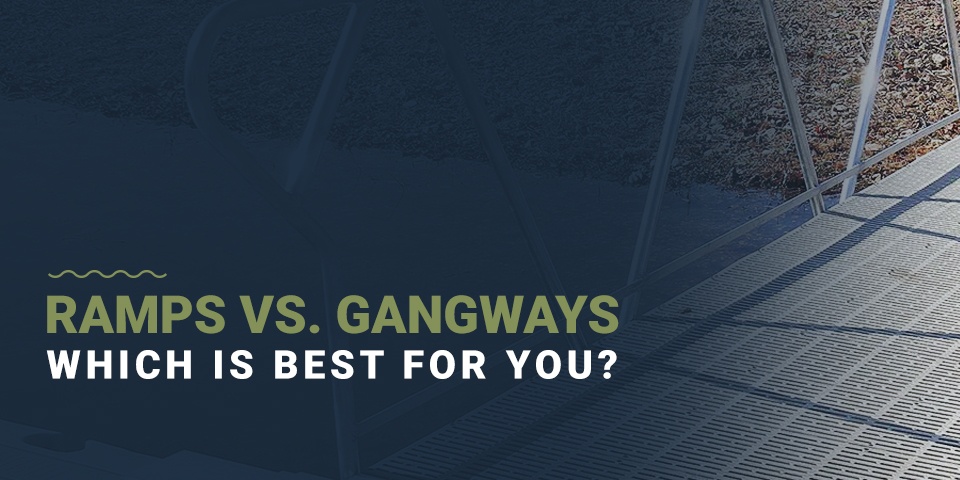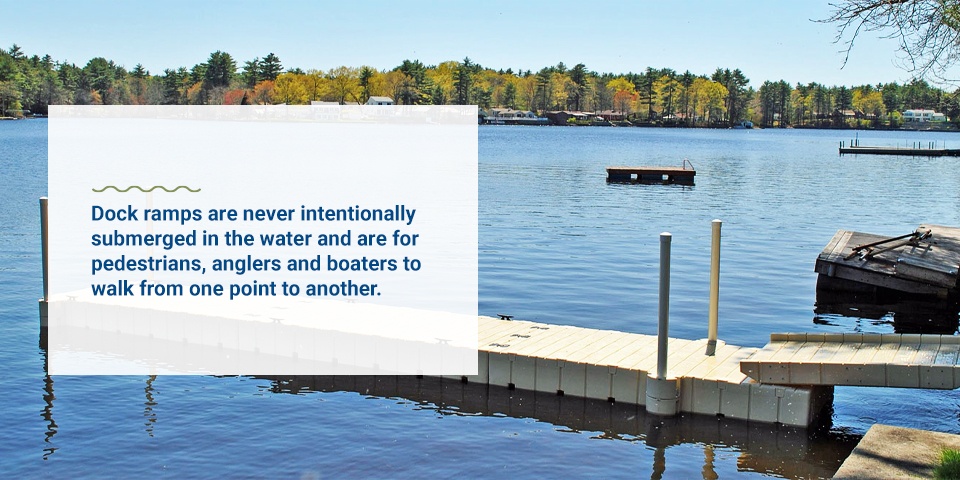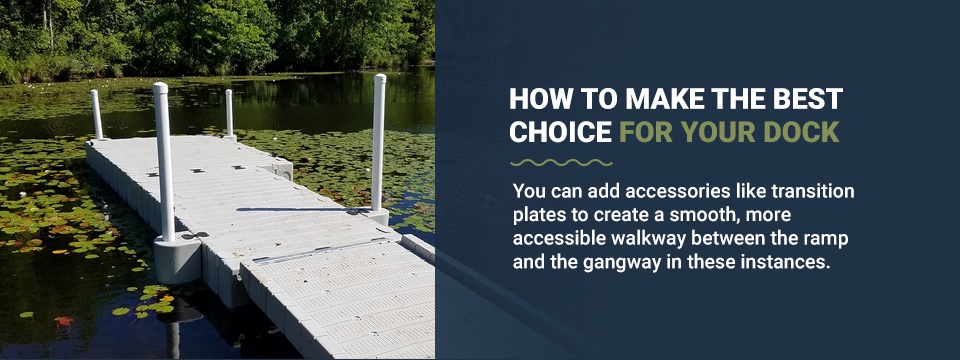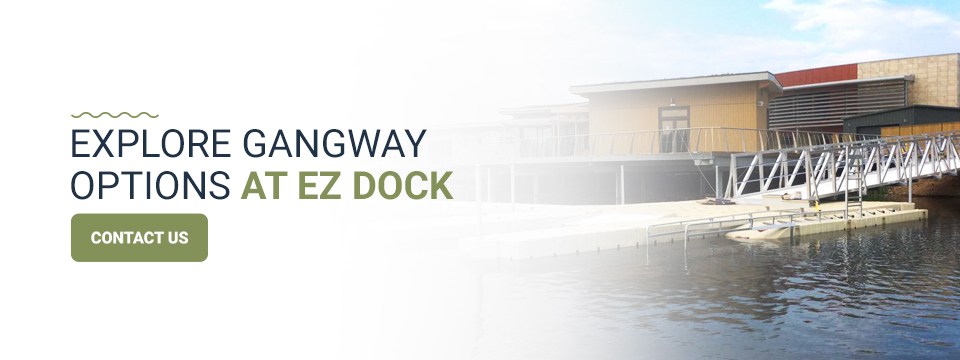Filters
Ramps vs. Gangways — Which Is Best for You?
Docks are a critical part of the boating experience, but specific property requirements and water conditions can make it impossible to install a dock directly near shore. That’s where ramps and gangways come in. When used together or as standalone units, ramps and gangways bridge the gap between land and water to make it safer, easier and faster to board, load, exit and unload vessels of all types and sizes.
Learn more about ramps vs. gangways for docks, including how to choose one for your commercial or residential property.
Read the full article or skip to a specific section:
- The Difference Between Ramps and Gangways
- Pros and Cons of Ramps
- Pros and Cons of Gangways
- How to Make the Best Choice for Your Dock
- Qualities of a Good Ramp or Gangway
The Difference Between Ramps and Gangways
Ramps and gangways are more similar than different. Ramps are generally shorter than gangways and often lack railings, but both gangways and ramps can connect a boat entry and exit point to the shore. They eliminate the need to jump or stretch across a large gap between the dock and boat, which can be especially dangerous for children, pets and those loading and unloading things like coolers, luggage, towels and gear. They also make it easier for individuals with disabilities to enter and exit a vessel.
You can add a gangway or ramp as a dock attachment in various applications and settings, including:
- Short distances.
- Long distances.
- Private or residential settings.
- Public and commercial waterways.
- Over steep declines or inclines.
- Over terrain and water.
In some cases, you may use them together, with a ramp bridging an incline directly from land and then joining with a gangway on the water for a safe path to the docked boats beyond. A gangway and a ramp can also be the same unit, depending on how you use it and its shape. In other cases, you may not need a gangway or a ramp at all, like level terrain near a deep body of water.
Pros and Cons of Ramps
Ramps connect steep shorelines and banks to boat docks or gangways. Don’t confuse these with boat ramps, which are partially submerged ramps you use to load and unload boats in the water, typically at a public facility. Dock ramps are never intentionally submerged in the water and are for pedestrians, anglers and boaters to walk from one point to another.
You might consider installing a dock ramp when:
- There is a steep or rocky decline between the land and your floating dock or gangway.
- You load or unload heavy cargo that may benefit from the incline or decline of a connecting ramp.
- A gangway alone is not enough to connect your dock to the shore, often due to fluctuating or shallow water.
Pros
Ramps for docks offer the following advantages:
- They are perfect for short distances: Ramps are ideal for bridging short gaps between a shoreline and boat dock, making it a simple, cost-efficient solution that takes minimal time and effort to install and maintain.
- They can cover steep drop-offs: If your waterfront property has steep natural inclines that make the dock impossible to access, a ramp is just what you need. It bridges steep inclined and declined terrain to create a more navigable, slightly sloped walking surface.
Cons
Before investing in a ramp for your waterfront property, consider the following:
- They are not as long as gangways: Most ramps are not as long as gangways, thanks to their natural sloped design. A gangway is the better option for shallow water that extends beyond a few feet or properties requiring long walkways between shore and dock.
- They typically lack railings: One of the most significant differences between ramps and gangways is railings. Most ramps do not come with railings as a part of the unit, which may be hazardous in some applications.
- They are not ideal for all water types: Unlike gangways, ramps are more stationary and not suitable for fluctuating water levels or rough water conditions because they can not adapt to the changes. In many cases, a ramp may become easily submerged or flooded during extreme weather.
Pros and Cons of Gangways
Gangways are floating platforms that attach to your dock and either the shore or a ramp that bridges the gap to land. Though some gangways refer to a special platform used to board and exit large ships or in warehouses for shipping purposes, aluminum and polyethylene gangways pair with residential or commercial floating docks to create a single usable path.
Gangways are an essential piece to your docking system if one or more of these situation applies:
- The water is too shallow or may lower to a hazardous level, making it impossible to install a floating dock system safely.
- You need boaters and dock users to access your dock from a specific part of your property and need something to bridge the gap.
- You want to create an accessible, easy-to-walk connector between the ramp or land that makes boating more enjoyable for all users.
Pros
Gangways for docks offer several advantages for your property, such as:
- They span greater distances: Gangways can reach greater lengths and span longer distances between the dock and shoreline because they are not limited by a sloped design. This makes them ideal for ponds and other shallow bodies of water without raised terrain.
- They typically have handrails: Most gangways automatically come with handrails for the sides or include an option to add them later. Handrails make gangways easier and safer to use, especially for young children and older adults — a crucial feature for many applications and properties with rough water.
- They are ideal for all water types: Floating gangways are more adaptable for varying water conditions and are less likely to become submerged or flooded during storms.
- They are more stable than ramps: Gangways are straight and steady, offering more stability for loading and unloading vessels.
Cons
Consider these possible disadvantages before selecting a gangway for your private or public property:
- They are not ideal for steep terrain: Though you may find a gangway with a ramp-like design, ramps are more suitable for steep terrain and drop-offs between the shore and water.
- They may require a connecting ramp: Once you select a gangway, you may find you still need a connecting ramp to attach the unit to your shoreline, especially on properties that aren’t flat and level.
- Handrails may limit width: Though handrails offer better protection and stability for users, they also limit the width for loading and unloading items from vessels, making it more challenging to handle things like long fishing poles.
How to Make the Best Choice for Your Dock
Not sure if you need a gangway, ramp or both to complete your docking system? Maybe none at all? Consider the following factors to make the best decision for your property:
- Railings: Some properties require railings for user safety or to maintain compliance with local regulations. Most gangways automatically come with the option to install protective railings, while ramps do not.
- Shoreline: Consider your shoreline’s shape and features. Are there any hills, rocks or drop-offs? Steep inclines or sharp declines? A ramp can bridge complex terrain conditions, while gangways are better suited for flatter or more level properties.
- Water: Measure the water depth surrounding your dock and compare it to the depth by your shoreline. Gangways are ideal for shallow water where floating docks cannot reach. Water conditions, like strong currents, high tides and waves, should also factor into your decision — ramps are more likely to flood, which is especially hazardous without handrails to maintain a firm grip when walking.
Some properties may require the use of both a gangway and a ramp, like terrains with steep inclines that meet shallow, rocky waters that cannot accommodate a near-shore dock. You can add accessories like transition plates to create a smooth, more accessible walkway between the ramp and the gangway in these instances. If your property presents no navigation challenges and your water is deep enough to support a floating dock near the shoreline throughout all four seasons, you may not require a gangway or ramp. Qualities of a Good Ramp or Gangway
Qualities of a Good Ramp or Gangway
A ramp or gangway is a significant investment for your property, and you want to ensure you’re making the best choice for your unique situation. The ideal unit is strong, secure and safe for all guests and boaters. Consider the material, compatibility with your existing dock system, ease of installation, safety features and required upkeep.
Material
Ramps and gangways are usually made of one of three common materials — aluminum, polyethylene or wood. In some cases — particularly with wooden structures — they may be combined with fasteners and hardware made from other, more durable materials. Consider longevity, upkeep and usability as you choose.
- Aluminum: Aluminum ramps and gangways are constructed out of a special marine-grade aluminum alloy that resists rust and corrosion from moving water, sun and other environmental conditions. They are strong and durable while still retaining the lightweight characteristic aluminum is known for. Aluminum is also available in multiple shapes, styles and configurations because it’s flexible and adaptable to most needs. EZ Dock aluminum gangways are welded together with bolted-in handrails.
- Polyethylene: Polyethylene is a type of plastic that resists warping and corrosion, even in constant water and sunlight. EZ Dock floating docks and gangways are made of polyethylene because they resist impact well and rise and fall with fluctuating water levels. These gangways are also resistant to heat absorption, so they’ll be comfortable all year long. EZ Dock polyethylene gangways attach via modular sections and attachment hardware, with optional handrails available.
- Wood: Wooden ramps and gangways require treated lumber or deck planks. They need more frequent upkeep than their aluminum and polyethylene counterparts. Still, they might be a suitable do-it-yourself solution for small, private or non-commercial docks that only need a short-term connection. Be mindful of wood rot and splinters and check with local environmental regulations regarding wood treatment chemicals. Wood ramps and gangways require extensive upkeep if you plan to use them all year long.
Compatibility
If you’ve already got an existing dock system, your chosen gangway or ramp must be compatible with it. EZ Dock floating docks sections and configurations are customizable and fit perfectly with EZ Dock aluminum and polyethylene floating gangways. Both docks and gangways are available in multiple sizes to accommodate various distances from land to dock.
EZ Dock aluminum gangways are available in 3-foot or 5-foot widths and in lengths from 8 feet to 32 feet.
EZ Dock polyethylene gangways are 39 inches wide, 10 feet long and 8 inches tall.
Both gangway types include optional accessories, like mounting kits and roller kits for increased stability, and a transition kit featuring ThruFlow technology for enhanced accessibility.
Safety
As a dock owner, safety for you, your guests and all docked boats is your top priority. Select a gangway or ramp with these safety features:
- Slip-resistance: Though gangways and ramps are never intentionally submerged, they will still get slippery during rain, strong waves and floods. They will also get wet naturally as boaters and swimmers walk across them. Be sure you choose a slip-resistant design with a textured surface for optimal grip.
- Heat-resistance: Some gangways and ramps can absorb heat and be very hot for bare feet and pet paws. Choose a heat-safe material, like polyethylene, that will protect sensitive skin and avoid discoloration in the sun.
- Splinter-free: Even treated wood can splinter or chip away over time, especially without frequent maintenance and repair. Splinters are dangerous and painful, and in public settings, a liability for your guests’ safety. Aluminum and polyethylene attachments are made of single-piece, non-splintering materials that are safe from rot and deterioration.
Installation
Depending on your property and the type and size of your gangway or ramp, you may be able to install your unit on your own or with a few extra hands. Other instances may require professional installation. EZ Dock gangways are easy to install after anchoring your dock, if applicable, and before adding any dock attachments.
For aluminum gangways, all you need is:
- A drill with a Phillips head bit.
- A ratchet and socket set.
- An open-end, boxed-end wrench set.
- A hand or electric saw.
- A tape measure.
Once you have all your supplies, you attach the handrail sections to the gangway base with provided nuts, bolts and washers before removing the necessary interlocking tabs. You then lay out the gangway decking panels and center them over the gangway before securing them with screws.
Polyethylene gangways require:
- A drill with a 3/8-by-7-inch drill bit.
- A Phillips head screwdriver.
- An open-end wrench or socket.
Begin by laying out all gangway sections with the textured walking side facing down. You then bolt the underside connection plates to the underside of the gangway sections before placing and securing the aluminum trusses. Connect with a drill, carriage bolts, washers and nuts.
Gangway accessories for aluminum and polyethylene units include a float-to-hinge kit, which attaches both aluminum and polyethylene gangways to a dock. Shoreline abutment kits help the gangway connect to the shoreline. Transition plates offer a steady, skid-resistant transition walkway between a shore and gangway. Optional rollers and roller kits allow the gangway to adjust with the water level for safer and more convenient use.
Maintenance
Like EZ Dock floating docks, EZ Dock gangways are easy to maintain and will serve your property for years to come. They require minimal upkeep and maintenance, thanks to their weather-resilient materials.
The most important part of caring for your gangway is winterizing it for the season if you live somewhere that experiences freezing temperatures, ice and snow. Winterizing your gangway or ramp helps protect it, your dock and the vulnerable shoreline from possible damage caused by floating ice formations and land erosion.
When winterizing your gangway, keep these tips in mind:
- Start as soon as — or a few weeks before — winter weather arrives to make the process easier and reduce the chance for surprise ice formations.
- Inspect your gangway before and after winterization and make any necessary adjustments or repairs.
- You can store your gangway the same way you do your floating dock — in a dry, covered location.
Explore Gangway Options at EZ Dock
EZ Dock uses top engineers and customer feedback to create innovative products that enhance your private or public docking experience, including aluminum and polyethylene gangways that attach to your new or existing dock. Learn more about EZ Dock gangways and explore product customizations and optional accessories to create a seamless experience for your dock users. Find a distributor near you, or request a quote today to get started.














